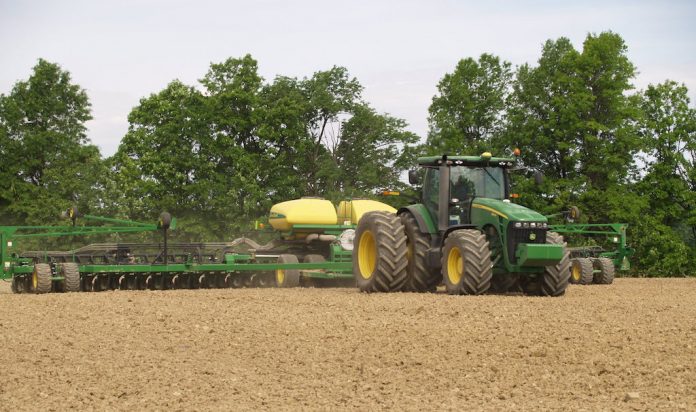Despite a wet, cold start to the planting season, row crop farmers in Ohio and Pennsylvania are mostly on track with planting for the year. Still, some are still trying to get into their fields to finish planting, and some are weighing whether to replant soybean acres that have struggled to get established under a lot of rain.
While farmers might be a little bit behind in some areas, it’s nothing like this time of year in 2019, when Ohio farmers weren’t even halfway through planting soybeans by the middle of June, said Laura Lindsey, a soybean and small grains specialist with Ohio State University Extension.
“I think it’s a little bit slower than normal,” she said. “There’s interest among farmers in replanting, and there seems to be some poor growth with corn and soybeans.”
Wet weather
The rainy conditions seem to be pretty widespread across Ohio, Lindsey said. She’s seen wet fields in northwestern Ohio, but also in the southern and northeastern parts of the state.
“I know there’s been windows where farmers could plant,” she said. “But you really have to take advantage of those windows.”
Replanting could be a challenge for farmers who decide to do it. Lindsey said she doesn’t encourage replanting for soybeans unless a stand is less than 50,000 plants per acre. That’s low, but soybeans can sometimes branch out and compensate for the low number of plants. If farmers wait for it to dry out, they might be waiting until the end of June or beginning of July, which is getting late to plant.
“Letting it go might be in the farmer’s best interest,” Lindsey said. “Trying to do a stand count, getting in the field and quantifying the plants per acre, is helpful.”
On track
Pennsylvania also saw a lot of early rain in some areas, but parts of Pennsylvania have been doing well. In April, Justin Jones, of Bradford County, Pennsylvania, was starting to think he might have to make use of prevent plant on a lot of his acres.
“We thought, no way in the world is this stuff going to dry out in a month,” he said. “But it dried out much quicker, and it dried out nicely.”
In May, he was able to catch up on planting. For the most part, he was done planting corn and soybeans by the end of the month. He just has about 100 acres of soybeans to replant, due to issues with slugs in some fields.
Jones was far from the only farmer to be concerned earlier in the year. As of May 9, Ohio and Pennsylvania farmers had planted only 5% and 13%, respectively, of their corn and Ohio only had 4% of its soybeans planted.
Five year averages for those crops at that time are 27% for corn in Ohio, 20% for corn in Pennsylvania and 14% for soybeans in Ohio, according to a U.S. Department of Agriculture crop progress report.
But by early June, both states were mostly back on track, as farmers got some more opportunities to get into their fields. The June 13 USDA crop progress report said Ohio had 93% of its corn and 80% of its soybeans planted, and Pennsylvania had 89% of its corn planted. All of those numbers are close to the five-year averages for that week of June.
Average year
In Lebanon County, Pennsylvania, John Harrell had his corn and soybeans in the ground before May 1. Harrell also has a Pioneer Seed dealership, and has heard that while a few of his customers are still planting soybeans, they have their corn in for the year.
A few storms may have damaged some wheat crops, and wet spells in early May slowed down some farmers on crops like rye and corn.
“I will say it seems like the earlier stuff is doing very well,” Harrell said. Rainfall has been good in his area, although a few lower-lying fields may have been set back by some heavier rains this spring. “But overall, it’s looking to be an average year. It’s so early to say … if it keeps raining, maybe a little better.”
Now, his main concern is protecting crops from disease.
“The biggest thing at this point for the crops is just walking fields and making sure, from a disease standpoint, nothing sets in to the beans or the corn,” he said.
Summer
In much of Ohio, farmers will need a break from the rainfall, but will need some consistent rain to continue so they don’t wind up with the opposite problem, Lindsey said. Weeds may be a bigger problem for soybeans in fields that didn’t get well established, since they’ll have less canopy cover, so many farmers will need to use herbicides this year, she added.
The National Integrated Drought Information System issued a drought early warning June 16 for Midwestern states including Ohio. Because that region is expected to see abnormally warm temperatures and below-normal precipitation at least through the end of June, parts of the region could see “flash droughts,” which are drought conditions that intensify quickly.
Jones is hoping to keep seeing sunshine in Pennsylvania and slightly warmer temperatures than what he’s been getting this spring. His no till fields can go a long time without rain if they need to.
“The beans look phenomenal … the corn is hit and miss. We haven’t had enough warm weather, in my opinion,” Jones said. He also made some changes with fertilizer this year because of prices, and he doesn’t think those changes have worked out well. “But I think we’ll recover, and I think it’ll be just fine.”
Late planting
For those who are still trying to get soybeans planted, Lindsey said while planting early is good, farmers are sometimes surprised by how well later-planted soybeans can do. She noted in 2019, a lot of farmers planted in the last half of June and were pleasantly surprised by their yields.
“So, don’t give up hope,” she added.












